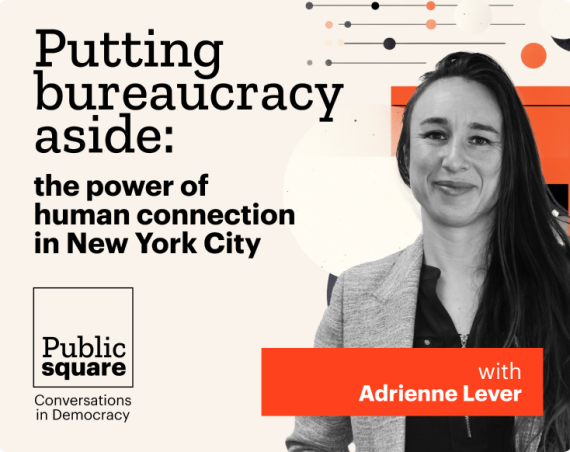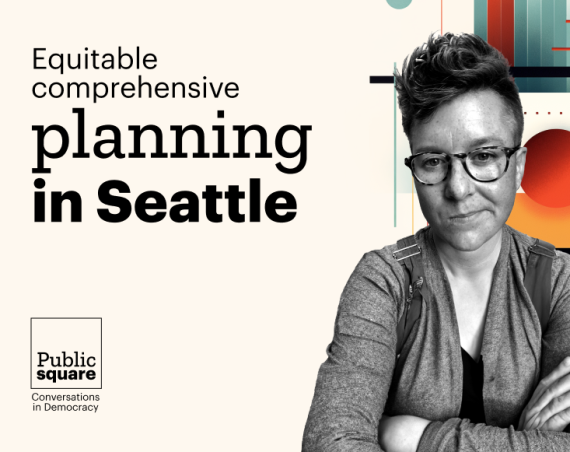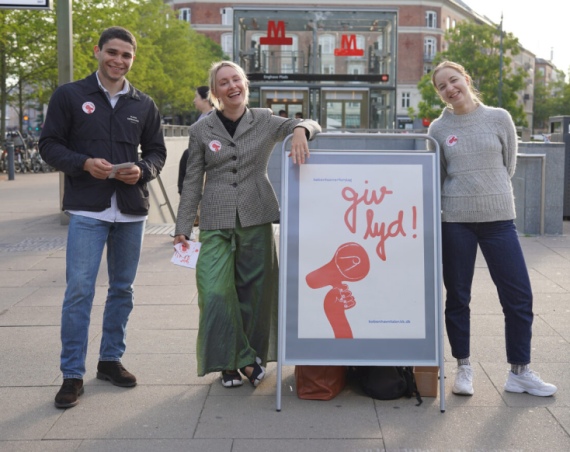In the 5 years since it was created, CitizenLab has helped hundreds of thousands of citizens share their ideas and voice their concerns. Here’s a deep dive into what they care most about.
Since its creation in 2016, CitizenLab has worked with hundreds of different cities across the world. Local governments use our platforms to provide a space for their residents to submit ideas, respond to surveys, distribute budgets, and co-create policies.
One of the participation methods most frequently used by cities is idea collection. This feature enables citizens to share their ideas and vote for those of other citizens that they would like to implement. Ideation is a powerful tool that allows innovative solutions to emerge while reinforcing the decision-making process’s transparency. To this date, more than 60 000 ideas have already been submitted.
But, as participation experts know, collecting ideas is only the start. Transforming large amounts of contributions into actionable insights can be a huge challenge for local government officials without the tools, knowledge, or means it takes to browse through the input and extract valuable insights. The CitizenLab platform, therefore, provides features for automated textual analysis to help civil servants make sense of the data that is collected on the platforms.
We used these features to compare results across cities and dig into broader participation trends. Are all citizens concerned with the same issues? Does it vary by age or gender? Do the residents of small cities have the same priorities as those of large capitals?
We analyzed all the 60 000 ideas and 1 080 000 upvotes submitted on our 451 CitizenLab platforms since 2015 and identified the most popular topics (those having received the most upvotes from users) across different factors: gender, age-groups, countries/regions and city size. The topic of these contributions can be either defined by the contributors themselves (who then pick from a drop down list), or defined by our automated analysis feature. We then used the data to draw beautiful charts.
The Most Upvoted and Downvoted Ideas
The most upvoted idea on CitizenLab was submitted by a young woman from Penalolen, Chile and received 1177 upvotes.
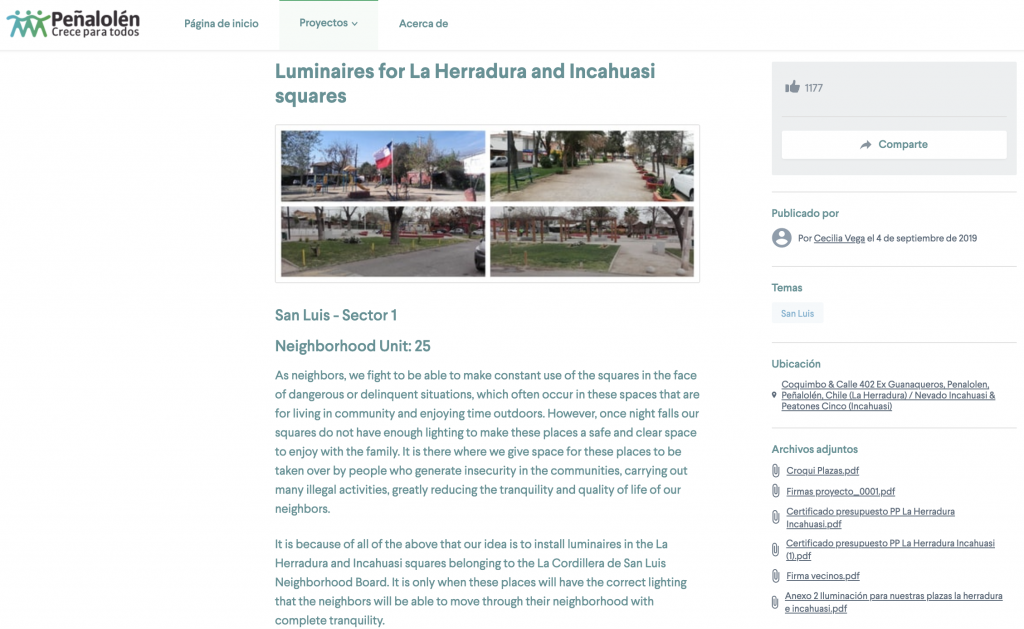
The most downvoted idea was submitted in Leuven, Belgium.
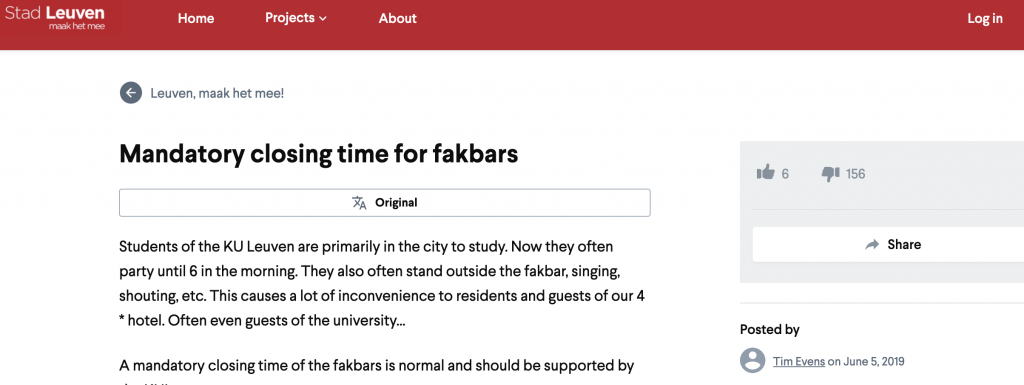
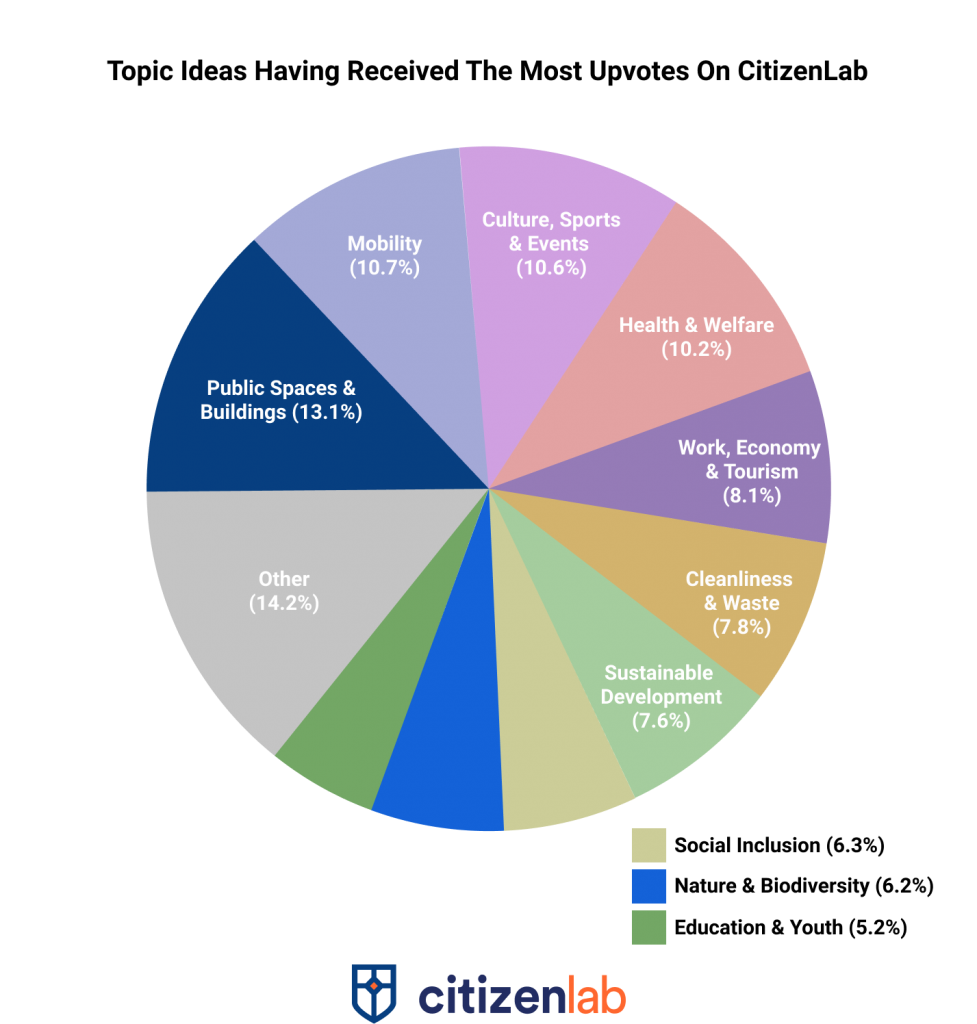
“Public spaces and building” was the identified topic which gathered the most upvotes, followed by “mobility”. However, as seen in the chart above, the distribution of upvotes appears extremely balanced. Indeed, the most popular topic only accounts for 13.1% of total upvotes and is only 5 points greater than the fifth most popular topic.
Preferences vary Greatly between Age Groups
To identify possible age-based variations in interests we divided the citizens in 5 different age groups (15-25, 25-35, 35-45, 45-60, 60+). Not all cities chose to collect the birth year of their citizens. Thus, only two-thirds (731 000) of the 1 080 000 total upvotes were made by users having submitted their birth year. Of those 731 000 upvotes, 89 948 (12%) were made by 15-25 years-old, 254 867 (35%) were made by 25-35 years-old, 187 993 (26%) were made by 35-45 year-old, 113 779 (16%) were made by 45-60 years-old, and 84 238 (12%) were made by 60+ years-old.
These results enabled us to observe important disparities between age groups as seen in the following bar chart.
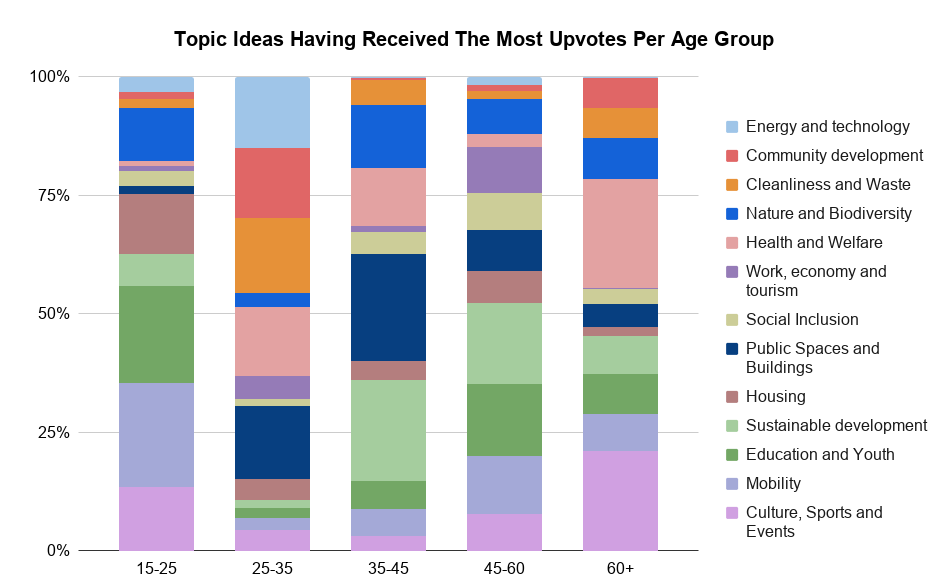
Main findings:
- 15-25 year-olds are the most concerned with Mobility and Housing. It could be because they are the most reliant on public transportation and cheap housing for their studies.
- Nature and Biodiversity, and Sustainable Development appear as important topics across all age groups. Indeed, apart from the 25-35 year olds, the subjects represent 15-35% of the total upvotes in the other groups.
- Elder (60+) and young people (15-25) are the most supportive of Culture, Sports & Events ideas. While this might seem surprising, 60+ and 15-25 year-olds are the ones with the most free time and can fully appreciate cultural and sporting events in the city.
- Health & Welfare is a priority for parents and the elderly. Most ideas upvoted by 25-35 and 35-45 years old concern childbirth, parenting, and children-related health and welfare issues. 60+ years old, on the other hand, to focus on issues of elderly care and the needs of senior citizens.
Men and Women are both preoccupied with Mobility, Nature, and Culture & Sports. Other priorities differ
Not all cities chose to collect the gender of their citizens. Thus, only half (445 000) of the 1 080 000 total upvotes were made by users having submitted their gender. While there are almost the same amount of men and women registered on the platform, it is worth noting that men appear more engaged on the platforms as they upvote and downvote more ideas than women (177 000 vs 268 000 upvotes and 21 000 vs 39 000 downvotes).
As seen in the charts below, men and women are preoccupied with similar issues. However, it is interesting to note that while Work, Economy & Tourism, and Education & Youth account for more than 20% of women upvotes, both topics account for only 10% of men upvotes. It is also worth mentioning that sustainable development and public spaces & buildings received twice as many men’s upvotes as women’s upvotes.
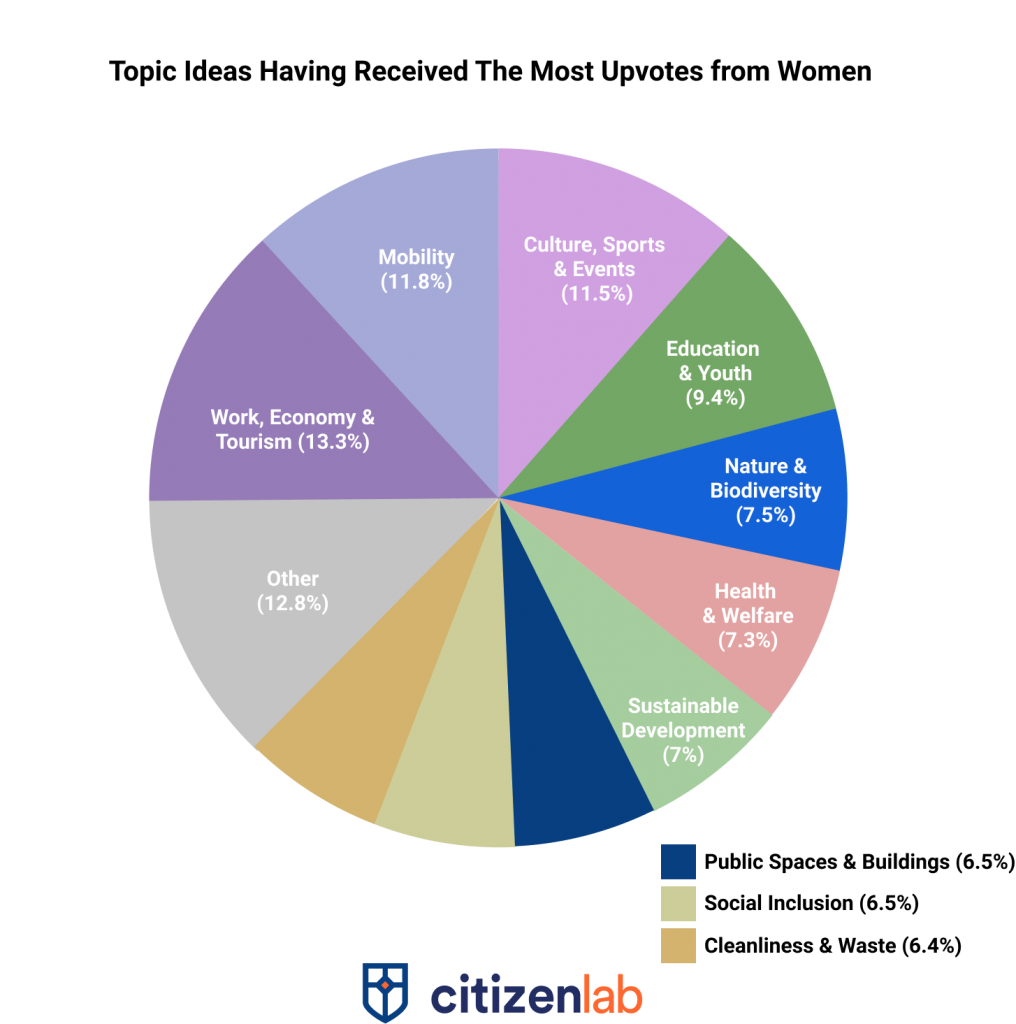
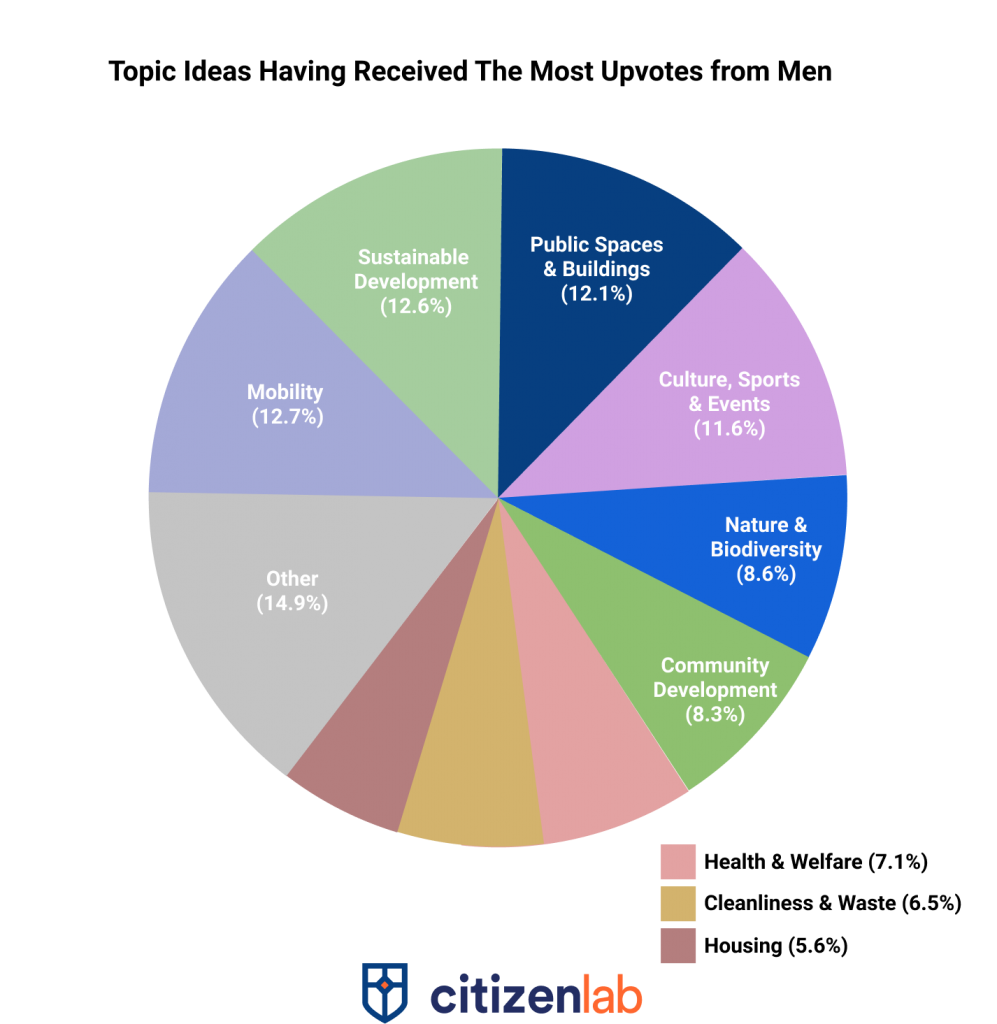
Inhabitants of small cities seem to have similar priorities to those of medium and large cities
To add a layer of analysis, we looked at the upvotes from citizens of small cities (>40 000 inhabitants), medium cities (40 000 – 120 000 inhabitants), and large cities (+120 000 inhabitants). It is worth noting that while small cities accounted for 46% of CitizenLab’s total clients, small city residents only represented 7% of the total upvotes on the platform. On the other hand, while large and medium cities accounted for 11% and 43% of CitizenLab’s total clients, their residents represented respectively 30% and 63% of all upvotes on the platform.
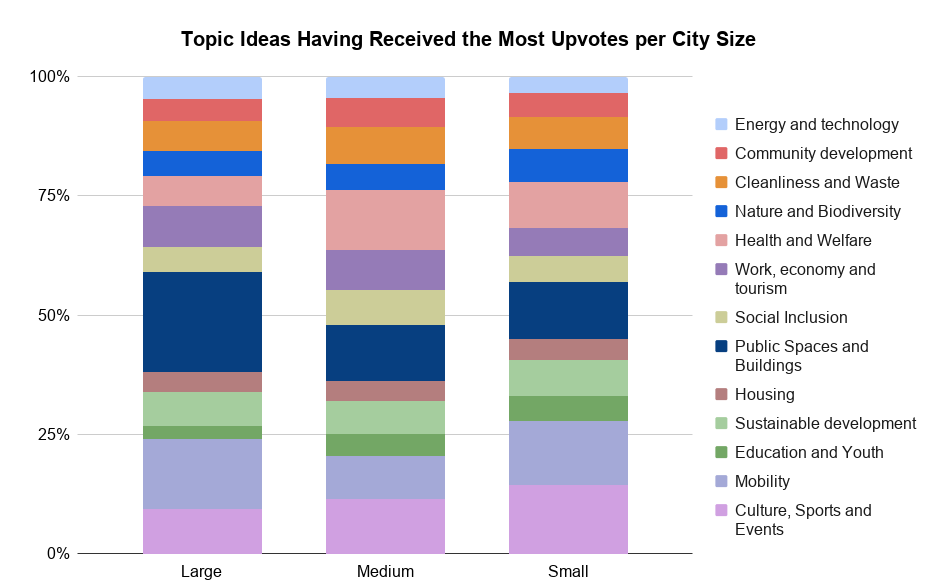
Main findings:
- The city’s size appears to have little influence on the importance of a topic to its citizens, as evidenced by the similarity between these bar charts.
- Large and small city inhabitants are both preoccupied with mobility issues. Indeed 14.5% of upvotes in large cities and 13.3% of upvotes in small cities regard mobility. In both cities, citizens seem concerned about traffic. Public transport appears more important in large cities.
- Culture, Sports, and Events suggestions are more prevalent in small cities. This could be because, in small towns, these play a more significant part in community life.
- Another big difference seems to be in the importance of public spaces and housing. In large cities, inhabitants are more reliant on public spaces and perhaps less likely to have houses and gardens.
The Netherlands and Germany have balanced topic distributions while other countries/ regions have important disparities
In an effort to understand how much geographical location has an influence on topics, we looked at the most popular topic by region. As seen below, one’s citizenship appears to have a significant influence on one’s topic preference.
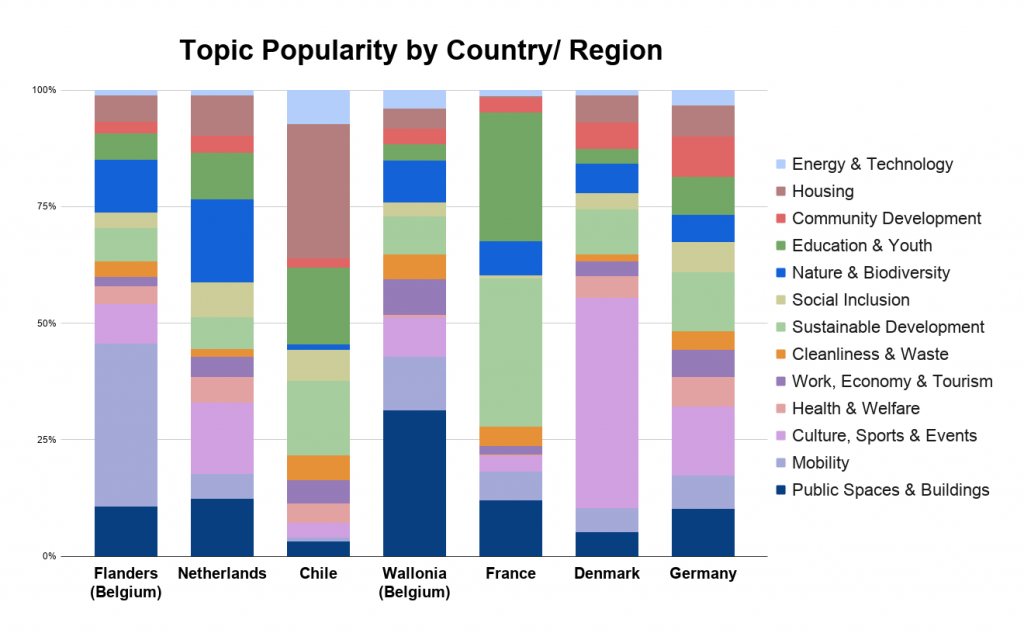
Main findings:
- The country/region seems to have a significant influence on the importance of a topic to its citizens. Germany and the Netherlands seem to share a similar pattern, but vote distribution varies greatly in the other regions. Wallonia and Flanders (two Belgian regions, which we separated for language issues) have similar upvotes distributions.Their main priorities differ (Mobility vs Public Spaces & Buildings),
- Half of the upvotes in Denmark concern Culture, Sports & Events. Other topics seem more evenly distributed.
- Education & Youth and Sustainable Development make up 60% of the total upvotes in France.
- Priorities in Chile resemble the most popular topics among 15-25 year-olds displayed in the age-group analysis above. These topics being Housing, Education & Youth, and Sustainable Development. This could be the result of a targeted municipal attempt to include young people in the policy process and/or because 15-25 year olds are the main users of the platform.
- The Flemish are very concerned with mobility. While these results are partly skewed by the 2019 Kortrijk digital referendum on a monthly car-free city center, in which 10 000 people participated, there were 31 000 total upvotes on this topic in Flanders, making it the most popular issue.
Final Observations
Our analysis of the impact of age, gender, city size and countries on topic popularity has illustrated that some factors are more influential than others. Age appears as the most significant given the strong variations between every age group. Countries/regions also appear to have a significant impact on a citizen’s topic preference. Gender comes third, as while there are some similarities in topic popularity between men and women, there are also significant variations. City size, on the other hand, appears to have a quasi-null impact on topic popularity.
If you want to learn more about the platform, don’t hesitate to get in touch with us, or schedule a demo!
Applying artificial intelligence to citizen participation: the Youth4Climate case study

